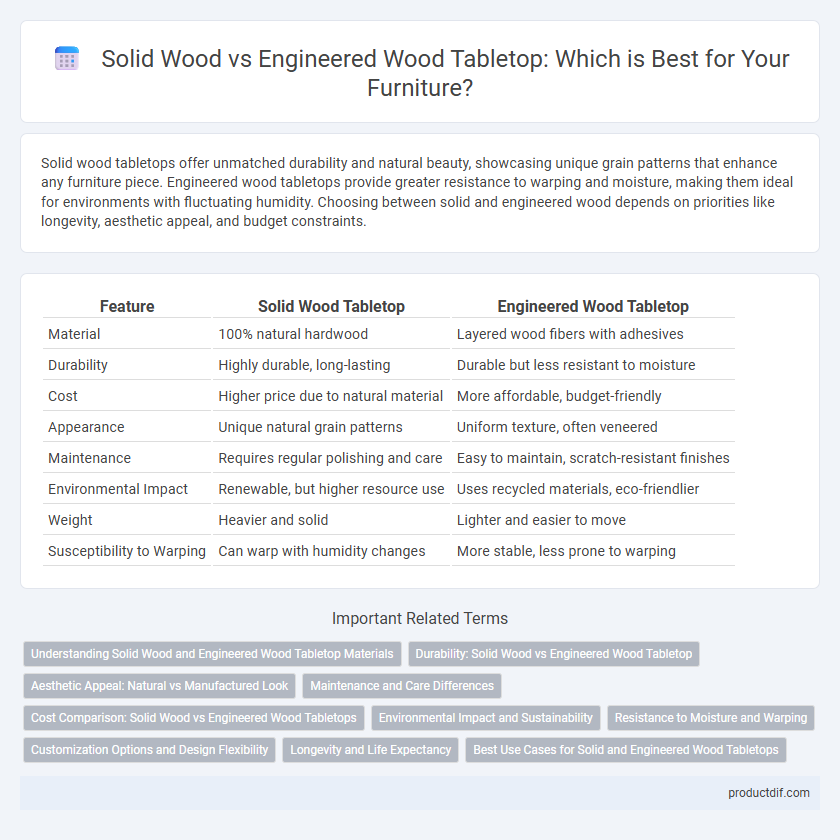Solid wood tabletops offer unmatched durability and natural beauty, showcasing unique grain patterns that enhance any furniture piece. Engineered wood tabletops provide greater resistance to warping and moisture, making them ideal for environments with fluctuating humidity. Choosing between solid and engineered wood depends on priorities like longevity, aesthetic appeal, and budget constraints.
Table of Comparison
| Feature | Solid Wood Tabletop | Engineered Wood Tabletop |
|---|---|---|
| Material | 100% natural hardwood | Layered wood fibers with adhesives |
| Durability | Highly durable, long-lasting | Durable but less resistant to moisture |
| Cost | Higher price due to natural material | More affordable, budget-friendly |
| Appearance | Unique natural grain patterns | Uniform texture, often veneered |
| Maintenance | Requires regular polishing and care | Easy to maintain, scratch-resistant finishes |
| Environmental Impact | Renewable, but higher resource use | Uses recycled materials, eco-friendlier |
| Weight | Heavier and solid | Lighter and easier to move |
| Susceptibility to Warping | Can warp with humidity changes | More stable, less prone to warping |
Understanding Solid Wood and Engineered Wood Tabletop Materials
Solid wood tabletops are crafted from natural timber, offering unique grain patterns, exceptional durability, and the ability to be refinished multiple times, making them a long-lasting investment. Engineered wood tabletops, such as plywood or MDF with veneer, provide enhanced resistance to warping and moisture due to their layered construction and adhesive process. Understanding these material differences helps consumers choose between the authenticity and repairability of solid wood versus the cost-effectiveness and stability of engineered wood options.
Durability: Solid Wood vs Engineered Wood Tabletop
Solid wood tabletops exhibit superior durability due to their dense grain structure, allowing for refinishing and resistance to deep scratches over time. Engineered wood tabletops, made from layered wood fibers or veneers bonded with adhesives, offer enhanced resistance to warping and moisture compared to solid wood but may degrade faster under heavy wear. Choosing between the two depends on the balance of longevity, maintenance, and environmental conditions impacting the furniture's lifespan.
Aesthetic Appeal: Natural vs Manufactured Look
A solid wood tabletop offers a rich, natural aesthetic with unique grain patterns and color variations that enhance its organic beauty. Engineered wood tabletops provide a more uniform, manufactured appearance, often designed to mimic natural wood but lacking the authentic texture and depth. The choice between solid and engineered wood significantly impacts the overall visual warmth and character of furniture pieces.
Maintenance and Care Differences
Solid wood tabletops require regular oiling or waxing to maintain their natural finish and prevent drying or cracking, while engineered wood tabletops often need only gentle cleaning with a damp cloth and mild detergent to preserve their veneer. Solid wood is more susceptible to humidity and temperature fluctuations, necessitating controlled indoor environments, whereas engineered wood offers better resistance to warping due to its layered construction. Repairing scratches or dents is more straightforward on solid wood, whereas engineered wood surfaces may require refinishing or replacement of the veneer layer.
Cost Comparison: Solid Wood vs Engineered Wood Tabletops
Solid wood tabletops typically cost more than engineered wood due to the material's durability, natural grain, and longer lifespan, ranging from $200 to $1000 depending on wood species and thickness. Engineered wood tabletops, such as plywood or MDF with veneer, offer a budget-friendly alternative priced between $100 and $400, providing similar aesthetic appeal but with less robustness. Choosing solid wood often results in higher upfront investment but greater long-term value, while engineered wood suits cost-conscious buyers seeking an affordable yet stylish surface.
Environmental Impact and Sustainability
Solid wood tabletops are made from natural, renewable hardwoods that promote sustainability through biodegradability and long-lasting durability, reducing the need for frequent replacement. Engineered wood tabletops, often manufactured using wood fibers and adhesives, can minimize waste by utilizing wood byproducts but may contain formaldehyde-based resins that affect indoor air quality and recyclability. Choosing solid wood supports sustainable forestry practices, whereas engineered wood's environmental impact depends largely on manufacturing processes and material composition.
Resistance to Moisture and Warping
Solid wood tabletops offer natural durability but are more susceptible to moisture absorption, which can lead to warping and cracking over time. Engineered wood tabletops, composed of multiple layers bonded with adhesives, provide superior resistance to moisture and maintain stability in varying humidity conditions. This enhanced moisture resistance makes engineered wood a preferred choice for environments prone to temperature fluctuations or high humidity.
Customization Options and Design Flexibility
Solid wood tabletops offer unparalleled customization options with the ability to be carved, stained, and reshaped to fit unique design preferences and furniture styles. Engineered wood tabletops provide greater design flexibility through consistent dimensions and easier manipulation for complex patterns or finishes, accommodating modern aesthetics. Choosing between solid and engineered wood impacts not only durability but also the range of customizable features available for bespoke furniture projects.
Longevity and Life Expectancy
Solid wood tabletops offer superior longevity with lifespans often exceeding 50 years due to their natural density and ability to be refinished multiple times. Engineered wood tabletops, made from layers of wood fibers and adhesives, generally have a shorter life expectancy of 10 to 20 years, as they are more prone to warping and damage from moisture. The durability of solid wood makes it a preferred choice for long-term furniture investments where lifespan and strength are critical factors.
Best Use Cases for Solid and Engineered Wood Tabletops
Solid wood tabletops are ideal for high-end furniture pieces, offering exceptional durability, natural beauty, and the ability to be refinished multiple times, making them perfect for dining tables and heirloom-quality desks. Engineered wood tabletops, including plywood and MDF with veneer finishes, excel in budget-friendly applications and environments prone to moisture and temperature changes, such as kitchen islands and office furniture. Their stability and resistance to warping make engineered wood suitable for mass-produced furniture that requires consistent quality and lower maintenance.
Solid wood tabletop vs engineered wood tabletop Infographic

 productdif.com
productdif.com